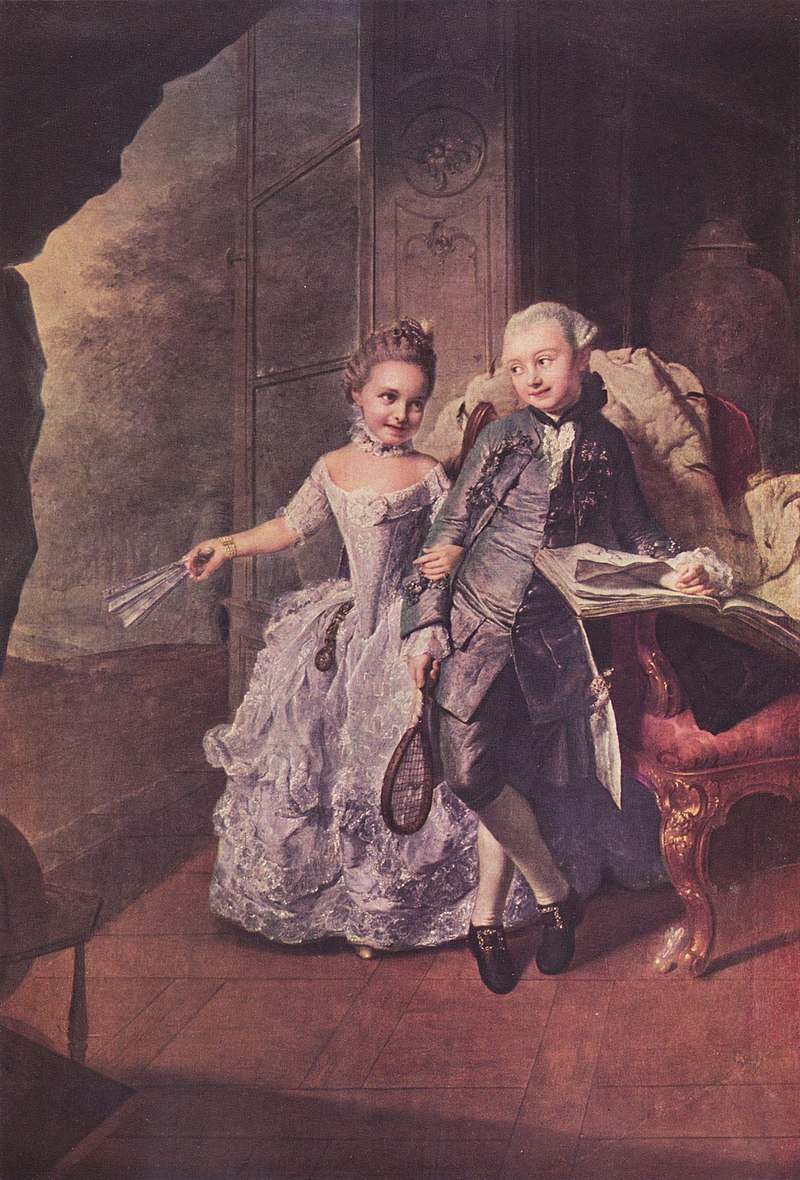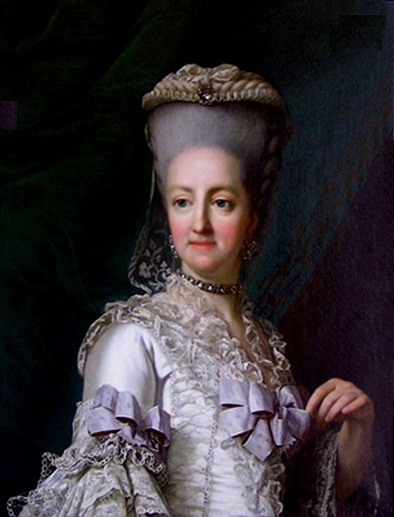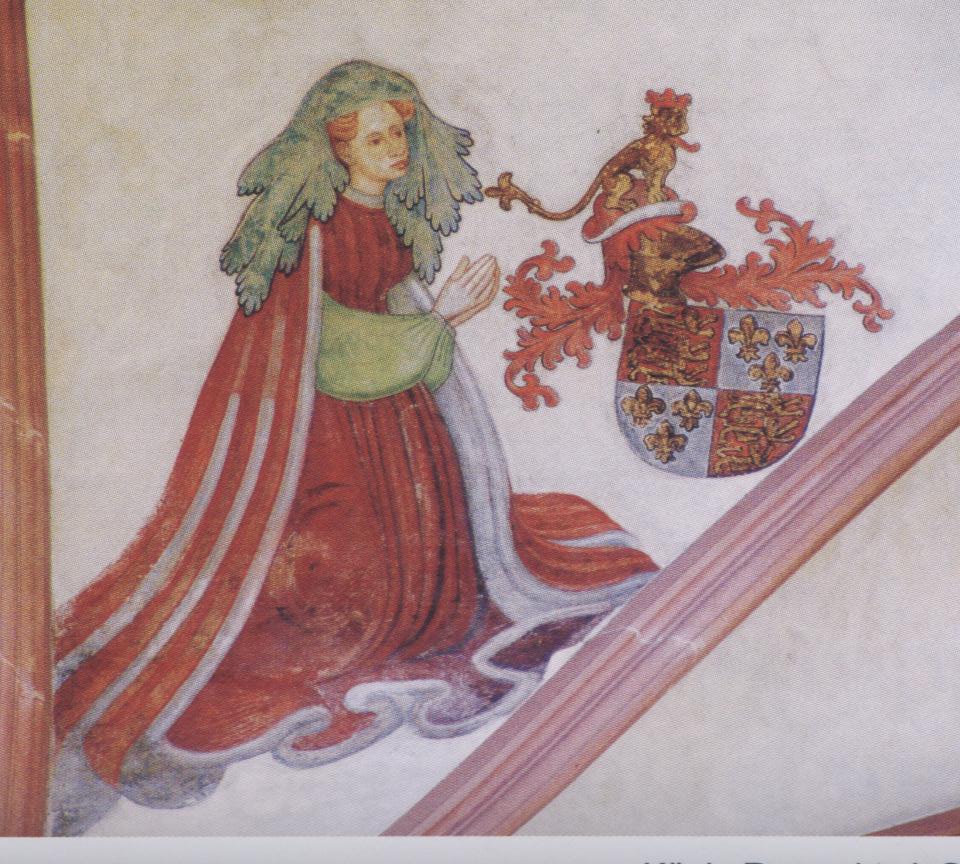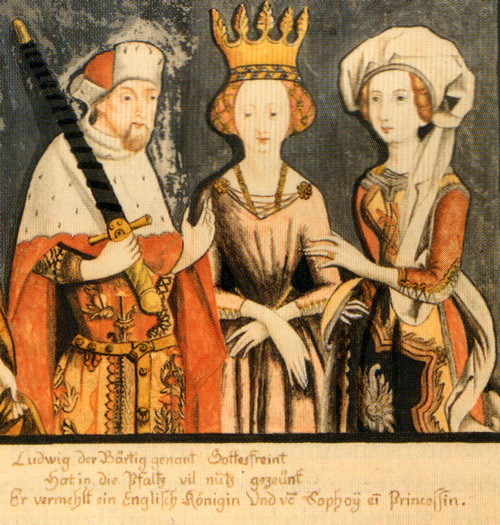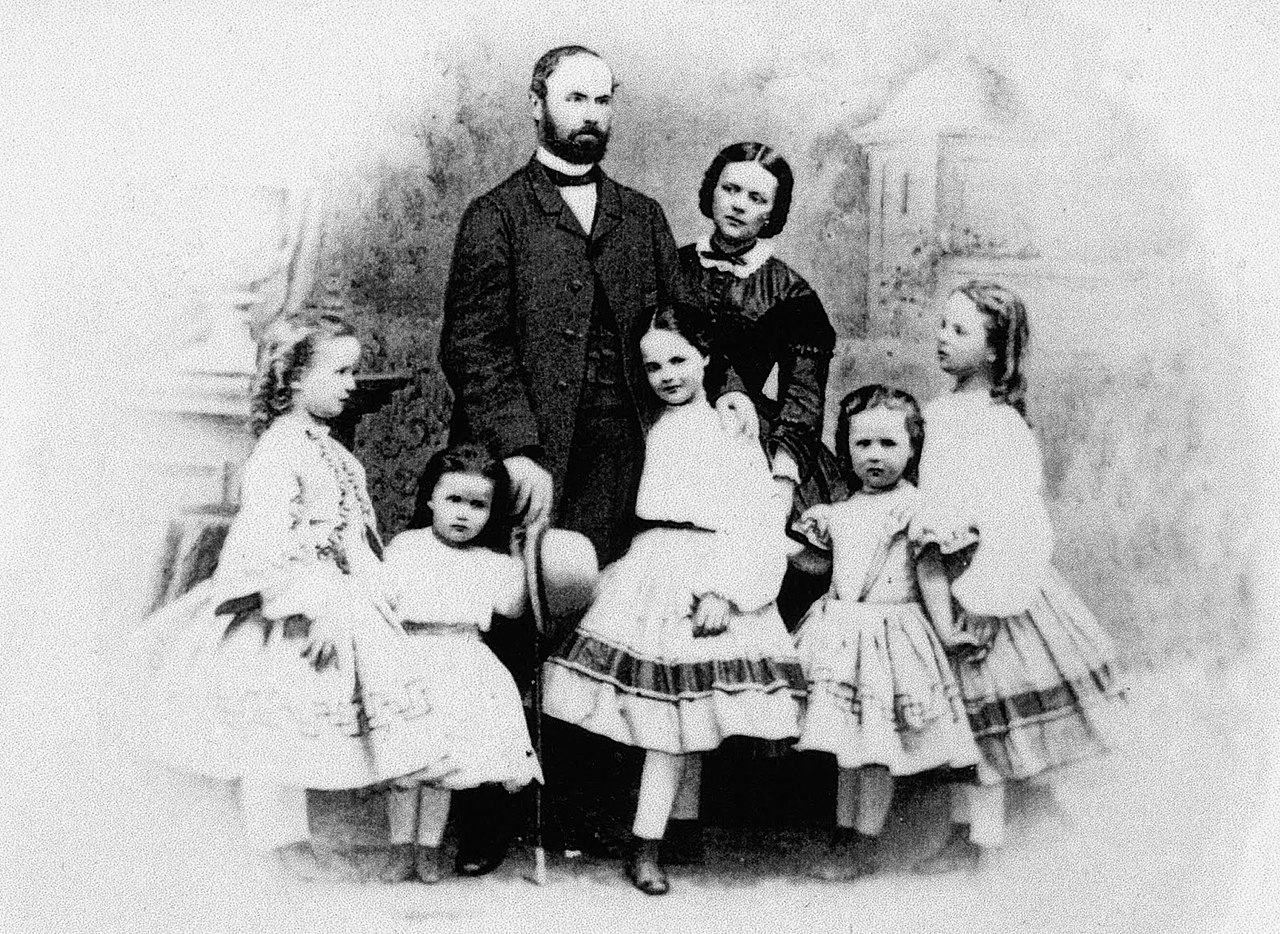by Susan Flantzer
© Unofficial Royalty 2022

Nicholas and Alexandra’s Feodorovna engagement photo; Credit – Wikipedia
Nicholas II, Emperor of All Russia and Princess Alix of Hesse and by Rhine were married on November 26, 1894, at the Grand Church of the Winter Palace in St. Petersburg, Russia.
*********************
Nicholas’ Early Life
Nicholas (standing behind his father) with his parents and siblings
Nicholas was the eldest of the four sons and the eldest of the six children of Alexander III, Emperor of All Russia and Empress Maria Feodorovna (born Princess Dagmar of Denmark). He was born May 18, 1868, at the Alexander Palace at Tsarskoye Selo, Russia. Nicholas’s brother Alexander, who was one year younger, died at the age of ten months from meningitis, and so Nicholas was raised with his brother George who was three years younger in a relatively simple manner considering their status. Nicholas and George slept in cots, woke up at 6:00 AM, took cold baths, and ate simple, plain meals. Their rooms were furnished with simple furniture. Both brothers were fluent in Russian, English, French, German, and Danish. The boys enjoyed shooting and fly fishing with their English tutor.
On March 13, 1881, Nicholas’ grandfather Alexander II, Emperor of All Russia was assassinated in St. Petersburg, a victim of a bombing by the underground organization, Narodnaya Volya (People’s Will), and Nicholas’ father succeeded to the Russian throne as Alexander III, Emperor of All Russia. 13-year-old Nicholas became the Tsesarevich of Russia, the heir to the throne.
*********************
Alix’s Early Life

Alix (in the middle, being hugged by her mother) with her parents and siblings, 1876; Credit – Wikipedia
Princess Alix of Hesse and by Rhine was the sixth of the seven children and the fourth of the five daughters of Ludwig IV, Grand Duke of Hesse and by Rhine and Princess Alice of the United Kingdom, daughter of Queen Victoria. Alix was born on June 6, 1872, at the Neues Palais in Darmstadt, Grand Duchy of Hesse and by Rhine, now in Hesse, Germany,
Nicknamed Sunny, she was a happy and beautiful child. The family lived a rather simple life, as they were not very wealthy by royal standards. In 1877, Alix’s father became the reigning Grand Duke, but the children’s lives remained mostly unchanged. They spent time with their grandmother Queen Victoria each year, relishing their visits to ‘Grandmama’ and looking forward to the next one. This relationship would become even closer in the coming years.
Tragedy struck the family in 1873, a week before Alix’s first birthday. Alix’s two-and-a-half-year-old brother Friedrich, known as Frittie had been diagnosed with hemophilia after a cut on his ear took several days to stop bleeding. On May 29, 1873, Frittie and his brother Ernst were playing in their mother’s bedroom. Ernst went into another room to look through the window which was at an angle to the window in Alice’s bedroom. While Alice was out of the room to get Ernst, Frittie climbed up to the window in the bedroom to try and see Ernst. From all accounts, the chair he had climbed on tipped over and Frittie fell from the window to the ground below. Due to his hemophilia, Frittie died from his injuries. As it turned out, Alix and her sister Irene were hemophilia carriers.
Tragedy struck again in 1878, when Alix was six-and-a-half years old. In November 1878, the family began to fall ill with diphtheria. Alix’s mother Alice quickly slipped into her role as caregiver, nursing her husband and children back to health. Sadly, her youngest child, four-year-old May, succumbed to the illness and died on November 16, 1878. Alice tried to keep the news from her husband and other children until they were in better health. Eventually telling her son Ernst, who was quite devoted to the young May, Alice broke the one rule of nursing this horrible illness. She comforted him with hugs and a kiss. Soon after, Alice herself began to fall ill and was also diagnosed with diphtheria. Her condition quickly deteriorated, and in the early morning of December 14, 1878, the 17th anniversary of the death of her father Prince Albert, Princess Alice, Grand Duchess of Hesse and by Rhine died at the age of 35. Queen Victoria stepped in to serve as a surrogate mother to the children, managing nearly every detail of their lives.
On March 13, 1892, when Alix was nineteen years old, her father Ludwig IV, Grand Duke of Hesse and by Rhine died from a heart attack at the age of 54. Alix deeply felt the loss of her father because he had been her only parent since she was six years old.
**********************
The Engagement

Queen Victoria, surrounded by her extended family, gathered for the wedding of Alix’s brother Ernst Ludwig, Grand Duke of Hesse and by Rhine to his first cousin Princess Victoria Melita of Edinburgh and Saxe-Coburg and Gotha in 1894. Nicholas and Alix are standing in the first row, second and third on the left. The photo was taken on April 21, 1894, the day after their engagement; Credit – Royal Collection Trust / © His Majesty King Charles III 2022
In June 1884, 16-year-old Nicholas attended the wedding of his uncle Grand Duke Sergei Alexandrovich to Princess Elisabeth of Hesse and by Rhine (Ella) in St. Petersburg, Russia. It was during the wedding festivities that he first met the bride’s younger sister, 12-year-old Princess Alix of Hesse and by Rhine. The two were second cousins through their mutual great-grandparents, Ludwig II, Grand Duke of Hesse and by Rhine and his wife Wilhelmine of Baden.
In 1889, 17-year-old Alix visited her sister Ella in St. Petersburg, Russia for six weeks. Alix and 21-year-old Nicholas saw each other at receptions, suppers, and balls. Nicholas took Alix ice skating and sledding. Before Alix returned home, Nicholas persuaded his parents to give her a special tea dance at the Alexander Palace at Tsarskoe Selo which later would become their favorite residence. Nicholas was smitten with Alix. In 1892, he wrote in his diary: “ My dream is someday to marry Alix H. I have loved her a long time and still deeper and stronger since 1889 when she spent six weeks in St. Petersburg. For a long time, I resisted my feeling that my dearest dream will come true.”
After the 1889 meeting, Alix thought Nicholas to be polite, charming, and gentle and liked his blue eyes. She noticed that Nicholas quietly persisted in pursuing her against his parents’ wishes. However, as a devout Lutheran, she was unwilling to give up her religion and convert to the Russian Orthodox religion, as would be required of her. Alix did have feelings for Nicholas and this caused her much turmoil, doubt, and self-examination.
A possible marriage between Alix and Nicholas was met with opposition from both Nicholas’ parents, and Alix’s grandmother Queen Victoria. Emperor Alexander III and Empress Maria Feodorovna felt that Alix was not suitable enough for their son, in part because of their dislike and distrust for all things German. They also hoped for a higher-profile bride and future Empress. As for Queen Victoria, she quite liked Nicholas personally. Ironically, considering what would happen to both Alix and her sister Ella in 1918, Queen Victoria also felt uneasy about another of her granddaughters marrying into the Russian Imperial Family. Instead, Queen Victoria pushed for a marriage between Alix and her first cousin Prince Albert Victor, known as Prince Eddy. Eddy was then second in line to the British throne after his father, the future King Edward VII. Eddy did propose and Alix rejected his proposal. Eddy died in 1892, resulting in his brother eventually succeeding to the throne as King George V.
In April 1894 in Coburg, Grand Duchy of Hesse and by Rhine, Nicholas represented his father at the wedding of Alix’s brother Ernst Ludwig, Grand Duke of Hesse and by Rhine and Princess Victoria Melita of Edinburgh and Saxe-Coburg and Gotha, Nicholas and Alix’s mutual first cousin. The wedding was attended by Queen Victoria, the grandmother of both the bride and groom, and much of her extended family. Before Nicholas left for Coburg, after much pestering, he received permission from his father to propose to Alix.
When Nicholas arrived in Coburg, Alix greeted him at the train station. That evening, they went to dinner and an operetta with the family. The next morning Nicholas proposed to Alix. Tearfully, Alix rejected his proposal because she objected to changing her religion. Later that day Queen Victoria arrived in Coburg. Apparently, she had a change of heart and now supported the marriage. Queen Victoria told her granddaughter that the Russian Orthodox religion was really not all that different from Lutheranism. The following day, Alix’s first cousin Wilhelm II, German Empire had a conversation with Alix, insisting that it was her duty to marry Nicholas, despite her religious objection. However, it was Alix’s sister Ella who made all the difference. Although Ella’s husband Grand Duke Sergei Alexandrovich was the son of an Emperor of All Russia, he was far removed from the throne and Ella was not required to convert to Russian Orthodoxy. However, she had converted voluntarily and she told Alix that a change of religion was not an enormous or unusual experience.
On April 19, 1894, during the wedding ceremony, a still saddened Nicholas closely watched Alix. Later in the day, he wrote in his diary, “How much I would have liked to have been able to look into the depths of Alix’s soul.” However, by the next day, things had completely changed. Alix had decided to marry Nicholas. The jubilant Nicholas wrote in his diary: “A marvelous, unforgettable day. Today is the day of my engagement to my darling, adorable Alix. After ten she came to Aunt Miechen [Grand Duchess Maria Pavlovna, the wife of Nicholas’ eldest uncle Grand Duke Vladimir Alexandrovich] and after a talk with her, we came to an understanding. O God, what a mountain has rolled from my shoulders…The whole day I have been walking in a dream, without fully realizing what was happening to me…I went straight with Alix to the Queen [Victoria]… The whole family was simply enraptured.”
Alix’s first cousin Princess Marie Louise of Schleswig-Holstein, who was the same age as Alix, wrote in her memoir: “I remember sitting in my room. I was quietly getting ready for a luncheon party when Alix stormed into my room, threw her arms around my neck, and said, ‘I’m going to marry Nicky!’”
The wedding was planned for the spring of 1895 but another tragedy caused those plans to be disrupted.
**********************
Disruption of the Wedding Plans

Alexander III’s death in Livadia by M.Zichy (Hermitage); Credit – Wikipedia
In 1894, Nicholas’s father Alexander III, Emperor of All Russia became ill with nephritis, a kidney disorder. Alexander was on his way to the Greek isle of Corfu where he hoped to recuperate at Mon Repos, the villa of his wife’s sister-in-law, Queen Olga of Greece. Born Grand Duchess Olga Konstantinovna of Russia, Queen Olga was also Alexander III’s first cousin. However, when Alexander reached Crimea, he was too ill to continue traveling and stayed at the Small Palace in Livadia, his home in Crimea. It was soon obvious that Alexander III would not survive and various relatives came to Crimea.
Alexander III instructed Nicholas to send for Alix, who arrived on October 22, 1894. Despite his ailing health, Alexander III insisted on greeting Alix in full uniform and gave her his blessing. Alexander III’s condition rapidly deteriorated and he died on November 1, 1894, at the age of 49, leaving the 26-year-old Nicholas as the new Emperor of All Russia. Since her engagement in April, Alix had been receiving instruction in the Russian Orthodox religion. The day after the death of Alexander III, Alix was received into the Russian Orthodox Church and was given the title and name Grand Duchess Alexandra Feodorovna of Russia. On November 18, 1894, after two weeks of Russian Orthodox ceremonies, and a procession from Crimea to St. Petersburg, via Moscow, Nicholas’s father was interred at the Cathedral of Peter and Paul in the Peter and Paul Fortress in St. Petersburg, Russia.
Nicholas and Alix’s wedding had been scheduled for the spring of 1895. Planning for the wedding had been ongoing since the April engagement and would have included a week of public celebrations and parades. However, Alexander III’s death necessitated a change in the wedding plans due to court mourning. Nicholas wanted to be married privately in Livadia before his father’s funeral and his mother agreed to this. However, his uncles, the brothers of his father, Grand Dukes Vladimir, Alexei, Sergei, and Paul argued that, as Nicholas was now the Emperor of All Russia, the wedding should be held in St. Petersburg with some pomp. With Nicholas unwilling to wait until the end of official mourning to marry, it was decided to hold the wedding on his mother’s birthday (November 26), which would allow for court mourning to be somewhat relaxed.
*********************
The Wedding Site

The Winter Palace in St. Petersburg, Russia; Credit – By Alex ‘Florstein’ Fedorov, CC BY-SA 4.0, https://commons.wikimedia.org/w/index.php?curid=49250446
The wedding site was the Grand Church of the Winter Palace on the Neva River in St. Petersburg, Russia. In the photo above of the Winter Palace, the golden cupola of the Grand Church can be seen on the left side of the photo. The Grand Church of the Winter Palace was a Russian Orthodox church that had cathedral status and was the site of most Romanov christenings, weddings, conversions of foreign princesses marrying into the family, and memorial services.

The Grand Church of the Winter Palace; Credit – By Januarius-zick – Own work, CC BY-SA 4.0, https://commons.wikimedia.org/w/index.php?curid=42460200
I have visited the Winter Palace on the banks of the Neva River in St. Petersburg, Russia and it is truly awe-inspiring. It was the official residence of the Russian Emperors and Empresses from 1732 to 1917. Today, part of the palace houses the State Hermitage Museum, one of the world’s premier art museums. The Winter Palace’s monumental scale was intended to reflect the might and power of Imperial Russia and it is still a mighty and powerful building. It is said to contain 1,786 doors, 1,945 windows, 1,500 rooms, and 117 staircases.
**********************
The Wedding Guests
Many of the foreign royalty who had come to St. Petersburg for the funeral of Alexander III, Emperor of All Russia remained in Russia for the wedding.
Family of the Groom
- Empress Dowager Maria Alexandrovna of Russia (born Dagmar of Denmark), mother of Nicholas II
- Grand Duchess Xenia Alexandrovna of Russia, sister of Nicholas II, and Grand Duke Alexander Mikhailovich of Russia, brother-in-law and first cousin once removed of Nicholas II
- Grand Duke Michael Alexandrovich of Russia, brother of Nicholas II
- Grand Duchess Olga Alexandrovna of Russia, sister of Nicholas II
- Grand Duke Vladimir Alexandrovich of Russia, paternal uncle and his wife Grand Duchess Marie Pavlovna of Russia (born Marie of Mecklenburg-Schwerin)
- Grand Duke Kirill Vladimirovich of Russia, first cousin of Nicholas II
- Grand Duke Boris Vladimirovich of Russia, first cousin of Nicholas II
- Grand Duke Andrei Vladimirovich of Russia, first cousin of Nicholas II
- Grand Duchess Elena Vladimirovna of Russia, first cousin of Nicholas II
- Grand Duke Alexei Alexandrovich of Russia, paternal uncle of Nicholas II
- Grand Duke Sergei Alexandrovich of Russia, paternal uncle of Nicholas II, and his wife Grand Duchess Elizabeth Feodorovna of Russia (born Elisabeth of Hesse and by Rhine), sister of Alexandra
- Grand Duke Paul Alexandrovich of Russia, paternal uncle of Nicholas II
- Grand Duchess Alexandra Iosifovna of Russia (born Alexandra of Saxe-Altenburg), paternal great aunt by marriage of Nicholas II
- Grand Duke Konstantin Konstantinovich of Russia, first cousin once removed of Nicholas II, and his wife Grand Duchess Elizabeth Mavrikievna of Russia (born Elisabeth of Saxe-Altenburg)
- Grand Duke Dmitri Konstantinovich of Russia, first cousin once removed of Nicholas II
- Duchess Vera of Württemberg (born Grand Duchess Vera Konstantinovna of Russia), first cousin once removed of Nicholas II (representing the King Wilhelm II of Württemberg)
- Grand Duke Michael Nikolaevich of Russia, paternal great-uncle of Nicholas II
- Grand Duke Nicholas Mikhailovich of Russia, first cousin once removed of Nicholas II
- Grand Duke George Mikhailovich of Russia, first cousin once removed of Nicholas II
- Grand Duke Sergei Mikhailovich of Russia, first cousin once removed of Nicholas II
- Christian IX, King of Denmark, maternal grandfather of Nicholas II
- George I, King of the Hellenes, maternal uncle of Nicholas II, and his wife Queen Olga of the Hellenes (born Grand Duchess Olga Konstantinovna of Russia), first cousin once removed of Nicholas II
- Prince George of Greece and Denmark, first cousin of Nicholas II
- Prince Valdemar of Denmark, maternal uncle of Nicholas II
Family of the Bride
- Ernst Ludwig, Grand Duke of Hesse and by Rhine, brother of Alexandra
- Prince Heinrich of Prussia, brother-in-law and first cousin of Alexandra, and Princess Heinrich of Prussia (born Irene of Hesse and by Rhine), sister of Alexandra (representing
- Wilhelm II, German Emperor, first cousin of Alexandra)
- The Prince of Wales (the future King Edward VII of the United Kingdom), maternal uncle of Alexandra, and The Princess of Wales (born Alexandra of Denmark), maternal aunt of Nicholas II (representing Queen Victoria of the United Kingdom, maternal grandmother of Alexandra)
- The Duke of York (the future King George V of the United Kingdom), first cousin of both Nicholas II and Alexandra
- Prince Alfred of the United Kingdom, Duke of Edinburgh and Sovereign Duke of Saxe-Coburg and Gotha, maternal uncle of Alexandra, and The Duchess of Edinburg and Duchess of Saxe-Coburg and Gotha (born Grand Duchess Maria Alexandrovna of Russia), paternal aunt of Nicholas II
- Crown Prince Ferdinand of Romania (the future King Ferdinand I of Romania), husband of Marie of Edinburgh, Crown Princess of Romania, first cousin of both Nicholas II and Alexandra (representing King Carol I of Romania)
Foreign Royalty
- Duke Johann Albrecht of Mecklenburg, second cousin once removed of Nicholas II (representing Friedrich Franz III, Grand Duke of Mecklenburg-Schwerin)
- Prince Wilhelm of Baden and Princess Maria Maximilianovna of Baden (born Maria Maximilianovna of Leuchtenberg), second cousin once removed of both Nicholas and Alexandra, and first cousin once removed of Nicholas II (representing Friedrich I, Grand Duke of Baden)
- Prince Eugen Maximilianovich Romanowsky, 5th Duke of Leuchtenberg, first cousin once removed of Nicholas II
- Prince George Maximilianovich Romanowsky (the future 6th Duke of Leuchtenberg), first cousin once removed of Nicholas II, and his wife Princess Anastasia of Leuchtenberg (born Anastasia of Montenegro)
- Duke Alexander Petrovich of Oldenburg, second cousin once removed, and Duchess Eugenia Maximilianovna of Oldenburg (born Eugenia Maximilianovna of Leuchtenberg), first cousin once removed of Nicholas II
- Duke Peter Alexandrovich of Oldenburg, second cousin of Nicholas II
- Duke Konstantin Petrovich of Oldenburg, second cousin once removed of Nicholas II
- Duke Georg Alexander of Mecklenburg-Strelitz, second cousin once removed of Nicholas II
- Duke Karl Michael of Mecklenburg-Strelitz, second cousin once removed of Nicholas II
- Prince Albrecht of Saxe-Altenburg, third cousin once removed of both Nicholas and Alexandra, and Princess Helene of Saxe-Altenburg (born Helene of Mecklenburg-Strelitz), second cousin once removed of Nicholas II (representing Ernst I, Duke of Saxe-Altenburg)
**********************
Groomsmen
In Romanov weddings, there were no bridesmaids, only groomsmen. Their main job was to hold the gold marriage crowns over the heads of the bride and groom during the Russian Orthodox wedding ceremony. The groomsmen for Nicholas and Alexandra’s wedding were:
- Grand Duke Michael Alexandrovich of Russia, brother of Nicholas II
- Grand Duke Kirill Vladimirovich of Russia, first cousin of Nicholas II
- Grand Duke Sergei Mikhailovich of Russia, first cousin once removed of Nicholas II
- Prince George of Greece and Denmark, first cousin of Nicholas II
**********************
The Wedding Attire
Nicholas wore the ceremonial dress uniform of a colonel in the Life Guards Hussar Regiment. The red tunic of the uniform was decorated with gold braid, gold epaulets, several rows of medals, and the orange sash of the Order of Hesse and by Rhine. The dark blue breeches were trimmed with gold braid.
Alexandra wore a dress modeled on the traditional Russian court dress. The silver brocade bodice was adorned with diamonds and embroidered with a leaf design in gold thread. The neckline was edged in white ermine and revealed Alexandra’s neck and shoulder. The long sleeves were edged in white ermine and hung in folds below the waist. The silver brocade overskirt was open in the front in an inverted V, revealing a silver tissue underskirt edged in ermine. The overskirt spread out from the waist into a fifteen-foot train edged in white ermine.
Alexandra’s hair was styled in the traditional style of Romanov brides. Her hair was in a bun at the back of her head and two ringlets that hung down to her shoulders were attached on either side of her head. She wore the same lace wedding veil designed by her grandfather Prince Albert for her mother Princess Alice. Alexandra’s sisters Victoria, Elisabeth, and Irene also wore the same veil when they got married. On her head, Alexandra wore the diamond Romanov nuptial tiara, formed like the traditional Russian kokoshnik headdress. In addition, she wore the diamond Romanov nuptial crown with a cross. For more information on the Romanov wedding jewelry see: The Royal Order of Sartorial Splendor: Russian Imperial Wedding Splendor
The photo below is not Alexandra but rather the first cousin of Nicholas II, Grand Duchess Elena Vladimirovna. The photo was taken on the day of Elena Vladimirovna’s wedding to Prince Nicholas of Greece in 1902. There is no photo of Alexandra on her wedding day but she would have been dressed in a similar manner. Notice on Elena’s head the Romanov nuptial tiara, in the front and the Romanov nuptial crown with the cross in the back.

Maria Alexandrovna’s niece Elena Vladimirovna dressed as her aunt would have been dressed on her wedding day; Credit – Wikipedia
**********************
The Wedding

The Wedding of Nicholas II and Alexandra by Laurits Tuxen, 1895; Credit – Wikipedia
As the guns from the Peter and Paul Fortress, just across the Neva River, fired a fifty-one-gun salute, the wedding procession began. Three thousand guests had been invited to witness the procession and they lined the halls of the Winter Palace. Proceeded by one hundred officials in pairs, Nicholas’ mother Dowager Empress Maria Feodorovna led Alexandra at the head of the procession, with Nicholas right behind. Members of Nicholas’s entourage came next, followed by the foreign royal guests headed by King Christian IX of Denmark, Nicholas’ maternal grandfather. Members of the Russian imperial family came next followed by Russian high-ranking government officials. As the procession reached the 1812 Gallery, members of the diplomatic corps, the Imperial Council, and the Council of Ministers joined the procession.
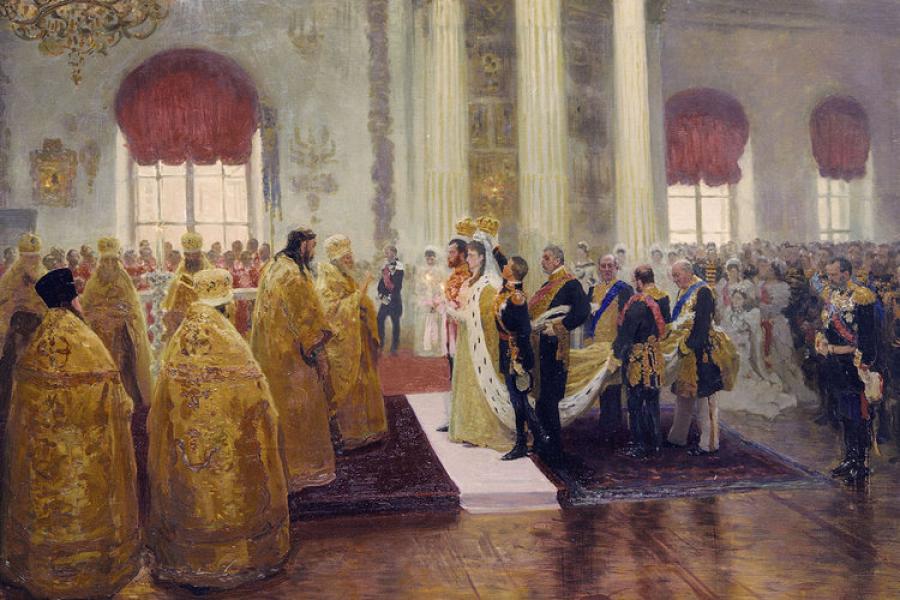
This 1894 painting by Ilya Repin shows the golden nuptial crowns being held over the heads of the bride and groom and shows where the guests stood; Credit – Wikipedia
Father Ioann Yanishev, the private imperial confessor and chief of the palace clergy, along with other clergymen, conducted the wedding service. After Nicholas had walked up the several steps to the dais, Dowager Empress Maria Feodorovna led Alexandra up the steps. Nicholas and Alexandra stood on a crimson carpet before a lectern on which lay the Gospels in a bejeweled cover. Father Yanishev announced the betrothal of Nicholas to Alexandra and then handed them their rings. After exchanging the rings three times in recognition of the Holy Trinity, Nicholas and Alexandra knelt and exchanged formal wedding vows. The four groomsmen took turns holding the golden nuptial crowns over the heads of the bride and groom, exchanging them three times. Nicholas and Alexandra joined hands and were led around the altar three times. They then knelt before the lectern and kissed a gold cross. Following a final prayer, Nicholas and Alexandra were pronounced man and wife. The church bells rang across St. Petersburg and guns were fired from the Peter and Paul Fortress.
**********************
After the Wedding
After the wedding, it was straight back to strict court mourning. There was no wedding breakfast or reception, and no honeymoon trip. Nicholas and Alexandra changed into traveling clothes and left the Winter Palace in an open landau drawn by four horses for the nearby Anichkov Palace, where Nicholas had spent his childhood. Nicholas wrote in his diary, “The streets were so crowded that we could hardly drive through them.” Nicholas saluted the crowds and Alexandra, in tears, nervously repeatedly bowed her head. The couple stopped at Kazan Cathedral, crowded with people, to pray before its famous icon. The landau proceeded to Anichkov Palace where the newlyweds were met by Nicholas’ mother Dowager Empress Maria Feodorovna with the traditional Russian welcome of bread and salt signifying plenty and good luck. Nicholas and Alexandra spent their first night as husband and wife in Nicholas’ former childhood bedroom. Meanwhile, in England, Queen Victoria held a banquet at Windsor Castle to celebrate the wedding, toasting the bride and groom and reading telegraphs from the new Empress Alexandra and from The Prince and Princess of Wales, who had traveled to Russia as her representatives.
**********************
Children

Nicholas and Alexandra with their children (circa 1913-1914); Credit – Wikipedia
Nicholas and Alexandra had four daughters and one son. Unfortunately, Alexandra was a hemophilia carrier and her son was a hemophiliac.
Nicholas, Alexandra, their five children, along with three of their most loyal servants and the court doctor, were shot to death by a firing squad during the Russian Revolution on July 17, 1918.
This article is the intellectual property of Unofficial Royalty and is NOT TO BE COPIED, EDITED, OR POSTED IN ANY FORM ON ANOTHER WEBSITE under any circumstances. It is permissible to use a link that directs to Unofficial Royalty.
Works Cited
- Ceremony of the wedding of Nicholas and Alexandra. Available at: https://www.alexanderpalace.org/wedding/ (Accessed: November 22, 2022).
- King, Greg. (2006) The Court of the Last Tsar: Pomp, Power, and Pageantry in the Reign of Nicholas II. Hoboken: Wiley.
- Laurits Regner Tuxen (1853-1927) – The Marriage of Nicholas II, Tsar of Russia, 26th November 1894 (no date) Royal Collection Trust. Available at: https://www.rct.uk/collection/404465/the-marriage-of-nicholas-ii-tsar-of-russia-26th-november-1894 (Accessed: November 22, 2022).
- Massie, Robert K. (1967) Nicholas and Alexandra. New York: Random House.
- Mehl, Scott. (2015) Alix of Hesse and by Rhine, Alexandra Feodorovna, Empress of All Russia, Unofficial Royalty. Available at: https://www.unofficialroyalty.com/princess-alix-of-hesse-and-by-rhine-empress-alexandra-feodorovna-of-russia/ (Accessed: November 22, 2022).
- Mehl, Scott. (2015) Nicholas II of Russia, Emperor of All Russia, Unofficial Royalty. Available at: https://www.unofficialroyalty.com/tsar-nicholas-ii-of-russia/ (Accessed: November 22, 2022).
- Royal Wedding,: 1894-12-01: Weekly Mail – Welsh Newspapers (1894) ROYAL WEDDING,|1894-12-01|Weekly Mail – Welsh Newspapers. Available at: https://newspapers.library.wales/view/3369740/3369752/105/ (Accessed: November 22, 2022).
- The Court Jeweller (2021) Romanov Splendor: The wedding tiara and jewels of Russia’s last Empress, The Court Jeweller. Available at: https://www.thecourtjeweller.com/2021/11/romanov-splendor-the-wedding-tiara-and-jewels-of-russias-last-empress.html (Accessed: November 22, 2022).
- The life and tragedy of Alexandra – chapter V – marriage and first year in Russia. Available at: https://www.alexanderpalace.org/alexandra/V.html (Accessed: November 22, 2022).
- To re-form the Russian Ministry; the usual pomp will be wanting in the marriage of czar Nicholas II. (1894) The New York Times. The New York Times. Available at: https://timesmachine.nytimes.com/timesmachine/1894/11/19/106879632.html?pageNumber=1 (Accessed: November 22, 2022).
- Wedding of Nicholas II and Alexandra Feodorovna (2022) Wikipedia. Wikimedia Foundation. Available at: https://en.wikipedia.org/wiki/Wedding_of_Nicholas_II_and_Alexandra_Feodorovna (Accessed: November 22, 2022).

